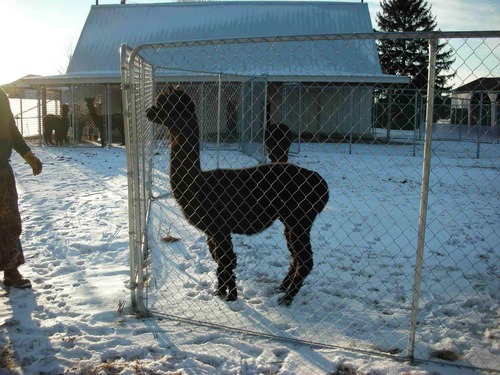|
June 26, 2013
Alpaca Fence
Good neighbors, good fence, safe alpacas.
By: Michael A. Morack

Good fence makes good neighbors. This defines fence that is best for alpacas considering that most livestock are injured by attacks from outside the fenced enclosure. Other than an amorous male, alpacas do not challenge the fence. These two facts best define how fence for alpacas should be chosen and designed.
Wire fence is preferred to wood, vinyl, or composite in our opinion. Wood fence provides containment for alpacas but fails to protect alpacas from animals outside the enclosure. Cria may also slip under a wooden fence without understanding how to get back to mother. Upkeep for wire is less than that of wood, vinyl, or composite.
Wire fence features are gauge (measure of strength or thickness of wire) and style (how it is designed). Gauge increases as thickness decreases. A 10-gauge wire is thicker than a 16-gauge wire. The minimum gauge we would recommend is 11.5 gauge. This seems to work regardless of the style of fence chosen.
When selecting style of fence we recommend chain link or woven wire fence. Let’s look at woven wire verses welded. Welded wire has two flaws. It does not conform well to topography and therefore is more difficult to install but we have also found it to be brittle. The brittle character arises as animals put stress folding the fence back and forth until it tears similar to paper that is folded until it can easily be ripped. This is not to say it will not work it just has limits when compared to woven wire or chain link.
Woven wire and chain link are more pliable to topography with woven being the easiest to conform. Chain link however, is the stronger of the two but this feature is offset by price. Chain link is superior when moving either existing fence lines or farms. It is easy to take down, transport, and place in a new location. Looking for salvage fence to reduce cost is very possible.
If choosing woven wire we would suggest the 2x4 inch spacing. This type prevents alpacas from sticking their heads through gaps reducing the risk of damage. This also has a higher resistance to animals entering the pasture. One other feature to woven we like is damage repair. If the fence sags, simply crimping the wire perpendicular to the sag will tighten the wire. To accomplish this, open a pair of pliers and place the jaws over the wire in the middle of the gap with the jaws open. Grabbing both sides of the handle, one hand on each handle, twist the handle in a circle. This will pull ¼ to ½ inch of sag out of the wire. Doing this multiple times across multiple gaps will stiffen the wire without replacement.
Last with regard to this discussion is height. We feel perimeter fence should be a minimum of five feet with a preference to six but then cost might be the determining factor. Internal fence at four feet is adequate to separate pastures, weaning, and most alpaca constraints. The exception is the amorous males. We believe this needs to be six feet in height with a top rail of pipe or wood to prevent injury when the male goes up on its hind legs. We also find the chain link superior to all wire under this circumstance. We have seen males up on hind legs with front legs through the wire and stuck.
The last consideration is site specific and relative to the types of wild animals that frequent your farm. We are not certain a fence exists that will deter a determined bear or Mountain Lion. In any event, external electric might deter a casual interest. We have heard that electric has little effect on alpacas but when hung up in the fence and getting zapped the alpaca will panic and cause serious injury to themselves.
There are a number of choices for posts. Posts are the strength and integrity of your fence. Like your choice of alpacas, choose the best poles you can afford. We like the galvanized for woven and “C” posts for chain link. Corner posts must be well braced to withstand the stretch and sag of the wire. We recommend 1/3 to ½ of the post length driven into the ground.
Fence is installed with the post in opposition to the anticipated challenge. This usually places the posts outside and wire inside. With alpacas we recommend the opposite in that most challenge comes outside the enclosure.

No Climb Woven

Chain Link

A-Cap Rail, B-Top Rail, C-Fabric, D-Bottom Rail, E-Post
|